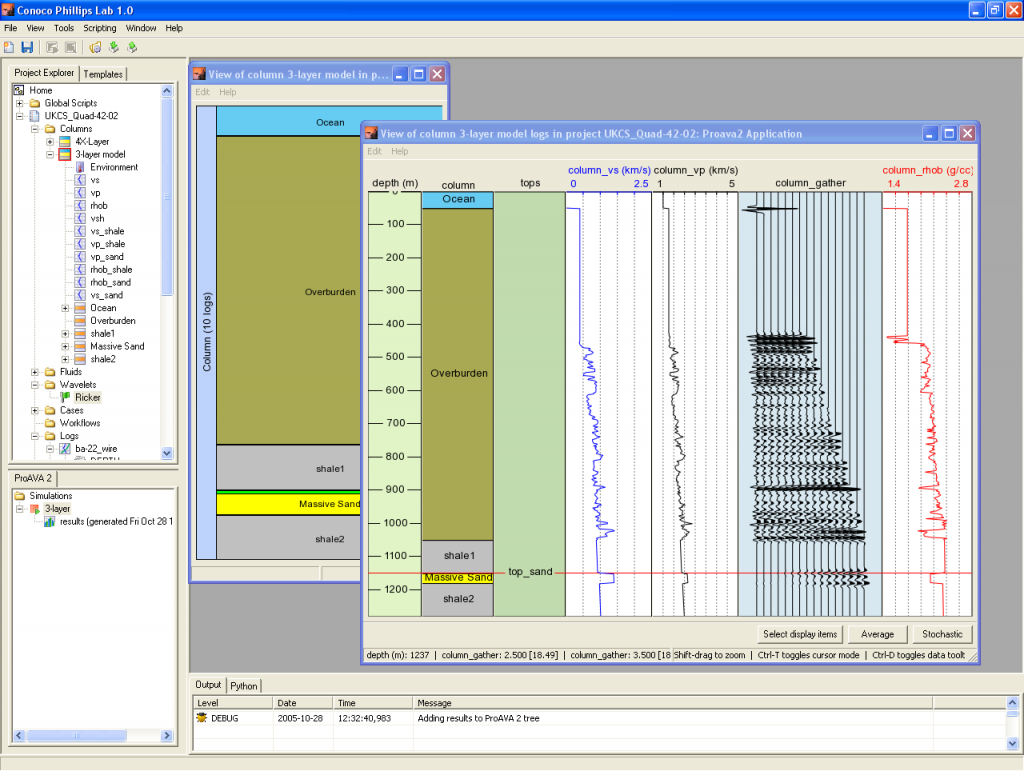CHALLENGE:
- Quantify the uncertainty involved in AVA (Amplitude Versus Angle) analysis
SOLUTION:
- Apply Monte Carlo techniques and Bayesian probability theory to estimate the probabilities of there being oil, natural gas, or just salt layer in the layer of interest
RESULTS:
- The user is able to construct a probabilistic model of what he thinks the Earth column at his prospect is
- The tool takes the model specification and generates many realizations of layer models with actual values
- Probability distributions can be compared with actual distributions
- Seismic synthetics are generated using the model to extract attributes from actual seismic data
Help ConocoPhillips apply advanced AI techniques to Amplitude Versus Angle (AVA), seismic analysis
Amplitude Versus Angle (AVA), seismic analysis is a well-established oil exploration tool. A set of seismic data around a particular point looking at a particular depth under ground can be summarized by numbers called attributes. Different rock properties, like being filled with oil, can vary the recorded attributes. However, the mapping is not unique; the same set of attributes can represent different models of the rock. In particular, the composition of the rock above the layer can affect the attributes, too. ConocoPhillips needed a tool to quantify the uncertainty involved in the AVA analysis.
Classic pore pressure prediction techniques were applied, for example 3D seismic velocity-to-pore-pressure transforms calibrated to offset wells. However, the greenfield motivated applying advanced AI techniques to see if models that provided more confidence could be derived.
Generate models to determine posterior probabilities of there being oil, natural gas, or salt water in the prospect
ProAVA uses Monte Carlo techniques and Bayesian probability theory to estimate the probabilities of there being oil, natural gas, or just salt water in the layer of interest. The user constructs a probabilistic model of what he thinks the Earth column at his prospect is.
Each layer can get its properties from a couple of different sources. The user can import a set of well log data that provides the properties as a function of depth. For some layers, the user may want to replace the properties with a specified value, or he may want to have the properties vary probabilistically in order to capture his uncertainty about their values. ProAVA will take this probabilistic model specification and generate many realizations of layer models with actual values under the three hypotheses of oil, natural gas, and salt water.
We generate seismic synthetics using this model and extract the attributes that we gathered on the actual seismic data. The probability distributions of the attributes are compared with the actual attributes, and a Bayesian calculation inverts this information to get posterior probabilities of there being oil, natural gas, or salt water in the prospect.
Use AI techniques to increase confidence in the model
Applying AI techniques, models were built that gave increased confidence in the pore pressure data. It was also important to develop local pore pressure models to support the real time data demands of drilling operations. Simplicity in data manipulation and presentation enabled the subsurface team to provide the support drilling operations demanded.
Sample Elements
Column construction

Well log plots

Posterior probability report

Simulation view | Envisage block canvas
